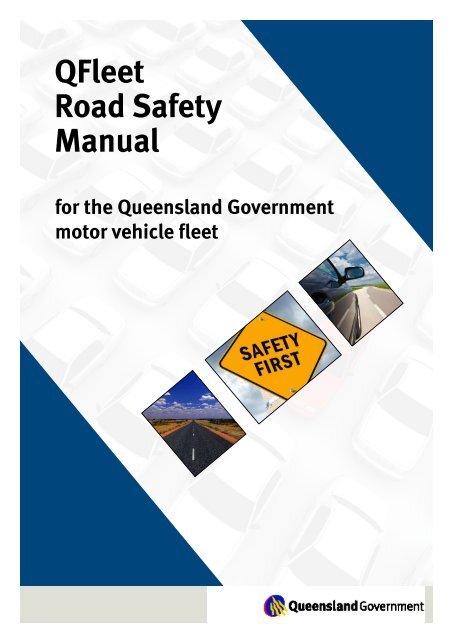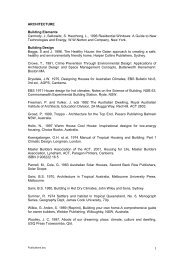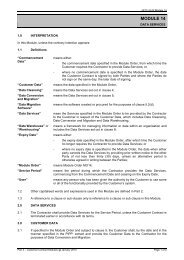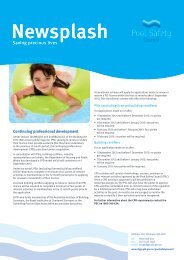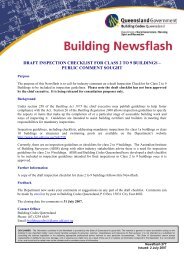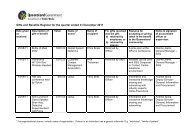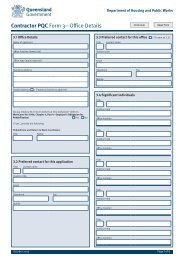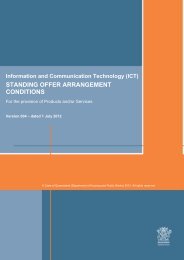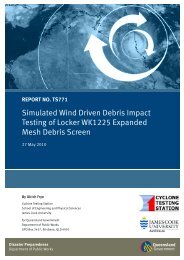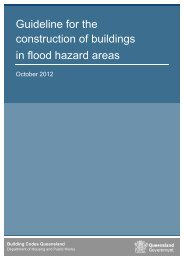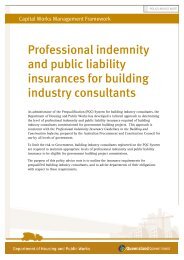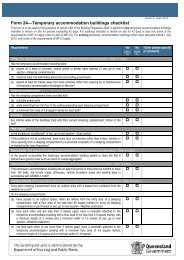QFleet Road Safety Manual - Department of Housing and Public ...
QFleet Road Safety Manual - Department of Housing and Public ...
QFleet Road Safety Manual - Department of Housing and Public ...
Create successful ePaper yourself
Turn your PDF publications into a flip-book with our unique Google optimized e-Paper software.
<strong>QFleet</strong><br />
<strong>Road</strong> <strong>Safety</strong><br />
<strong>Manual</strong><br />
for the Queensl<strong>and</strong> Government<br />
motor vehicle fleet
<strong>QFleet</strong> <strong>Road</strong> <strong>Safety</strong> <strong>Manual</strong><br />
for the Queensl<strong>and</strong> Government motor vehicle fleet<br />
Amended January 2012<br />
Version 1.1<br />
First Edition<br />
<strong>QFleet</strong><br />
October 2010<br />
ISBN 978-1-921670-01-5<br />
© State <strong>of</strong> Queensl<strong>and</strong> (<strong>Department</strong> <strong>of</strong> <strong>Public</strong> Works)<br />
2010. All rights reserved.<br />
No part <strong>of</strong> this document may be produced by any<br />
process, electronic or otherwise, in any material<br />
form or transmitted to any other person or stored<br />
electronically in any form, without prior written<br />
permission <strong>of</strong> copyright holder, except as permitted<br />
under the Copyright Act 1968 (Cth).<br />
Enquiries should be directed to:<br />
The Manager<br />
Policy <strong>and</strong> Communications Branch<br />
<strong>QFleet</strong><br />
PO Box 293<br />
Brisbane Qld 4001<br />
mail@qfleet.qld.gov.au
Contents<br />
Acknowledgements...................................................3<br />
Foreword...................................................................4<br />
Introduction..............................................................5<br />
Safe work-related driving is a shared responsibility... 5<br />
Work-related driving in Australia is a major risk<br />
exposure for employers............................................. 5<br />
WHS law <strong>and</strong> work-related driving safety...................7<br />
Vehicle <strong>and</strong> driver safety is covered by both WHS<br />
legislation <strong>and</strong> road traffic laws ................................ 7<br />
Employees also have WHS obligations....................... 8<br />
Fleet management <strong>and</strong> work-related driver safety<br />
program....................................................................9<br />
Structure <strong>of</strong> the <strong>Manual</strong>: a risk management approach<br />
to work-related driving safety ...................................11<br />
Section 1: Assess risk factors on <strong>and</strong> <strong>of</strong>f the road......12<br />
Identification <strong>of</strong> hazards............................................ 12<br />
Workplace risk assessment....................................... 13<br />
Section 2: Identify <strong>and</strong> implement control measures .18<br />
Create a culture <strong>of</strong> work-related driving safety .......... 18<br />
Consult on work-related driving................................. 19<br />
Develop work-related driving safety policies <strong>and</strong><br />
procedures ............................................................... 19<br />
Select safe vehicles................................................... 20<br />
Maintain a safe fleet.................................................. 21<br />
Ensure drivers are competent <strong>and</strong> fit to drive............. 22<br />
Inform <strong>and</strong> supervise drivers..................................... 22<br />
Plan trips to minimise risks........................................ 23<br />
Section 3: Monitor <strong>and</strong> review work-related driving<br />
safety........................................................................24<br />
Emergency response................................................. 24<br />
Recovery <strong>and</strong> reporting.............................................. 24<br />
Investigation............................................................. 24<br />
Routine monitoring.................................................... 24<br />
Review ...................................................................... 24<br />
Audit ........................................................................ 25<br />
Modification ............................................................. 25<br />
Enquiries ..................................................................26
Important Notice<br />
The information presented in the <strong>QFleet</strong> <strong>Road</strong> <strong>Safety</strong><br />
<strong>Manual</strong> for the Queensl<strong>and</strong> Government motor<br />
vehicle fleet (the <strong>Manual</strong>) <strong>and</strong> information contained<br />
in links to associated resources is intended for<br />
general information only. The <strong>Manual</strong> should not<br />
be viewed as a definitive or up-to-date guide to the<br />
law. Readers should refer to the Work Health <strong>and</strong><br />
<strong>Safety</strong> Act 2011, Work Health <strong>and</strong> <strong>Safety</strong> Regulation<br />
2011, Transport Operations (<strong>Road</strong> Use Management)<br />
Act 1995 <strong>and</strong> Transport Operations (<strong>Road</strong> Use<br />
Management – <strong>Road</strong> Rules) Regulation 2009 for<br />
information in relation to workplace health <strong>and</strong><br />
safety obligations <strong>and</strong> road rules <strong>and</strong> seek their own<br />
legal advice regarding their legal obligations.<br />
Amendments to the <strong>Manual</strong>:<br />
Version 1.1 January 2012<br />
Version 1.1 <strong>of</strong> the <strong>Manual</strong> incorporates the following<br />
changes:<br />
1. The reference to Workplace Health <strong>and</strong> <strong>Safety</strong> Act<br />
1995 (Qld) on Page 2 replaced with Work Health<br />
<strong>and</strong> <strong>Safety</strong> Act 2011.<br />
2. The reference to Workplace Health <strong>and</strong> <strong>Safety</strong><br />
Regulation 2008 (Qld) on Page 2 replaced with<br />
Work Health <strong>and</strong> <strong>Safety</strong> Regulation 2011.<br />
Text deleted from Page 20, para 2:<br />
3. ‘ ...intelligent<br />
speed adaptation <strong>and</strong> emergency crash<br />
notification’.<br />
2 <strong>Road</strong> <strong>Safety</strong> <strong>Manual</strong>
Acknowledgements<br />
The <strong>QFleet</strong> <strong>Road</strong> <strong>Safety</strong> <strong>Manual</strong> for the Queensl<strong>and</strong><br />
Government motor vehicle fleet is based on the<br />
publication: A h<strong>and</strong>book for workplaces: Guide to<br />
safe work-related driving, November 2008, Edition<br />
No 1, a joint initiative <strong>of</strong> the Victorian Transport<br />
Accident Commission (TAC) <strong>and</strong> WorkSafe Victoria.<br />
Reference can be made to this source at either<br />
www.worksafe.vic.gov.au or www.tac.vic.gov.au.<br />
<strong>QFleet</strong> has been granted a non-exclusive licence to<br />
use this work for the purposes <strong>of</strong> the <strong>Manual</strong>.<br />
As A h<strong>and</strong>book for workplaces: Guide to safe workrelated<br />
driving, November 2008, Edition No 1<br />
forms a substantial part <strong>of</strong> the <strong>Manual</strong> in terms <strong>of</strong><br />
content <strong>and</strong> structure, material is not separately<br />
referenced as footnotes throughout the <strong>Manual</strong>.<br />
This acknowledgement therefore acts as a principal<br />
reference <strong>of</strong> that source.<br />
Approval has also been granted to <strong>QFleet</strong> to use<br />
material referenced in the <strong>Manual</strong> where the<br />
information forms a substantial part <strong>of</strong> copyright<br />
material from third party sources. All research<br />
material has been referenced as necessary using<br />
footnotes throughout the <strong>Manual</strong>. In particular,<br />
<strong>QFleet</strong> acknowledges the valuable input <strong>of</strong> research<br />
conducted by the Centre for Accident Research<br />
<strong>and</strong> <strong>Road</strong> <strong>Safety</strong> – Queensl<strong>and</strong> (CARRS-Q) <strong>and</strong><br />
the Monash University Accident Research Centre<br />
(MUARC) used in the <strong>Manual</strong>.<br />
<strong>QFleet</strong> would like to thank all contributors <strong>and</strong><br />
acknowledges their support <strong>of</strong> <strong>QFleet</strong>’s <strong>Road</strong> <strong>Safety</strong><br />
Program for the Queensl<strong>and</strong> Government motor<br />
vehicle fleet.<br />
<strong>Road</strong> <strong>Safety</strong> <strong>Manual</strong><br />
3
Foreword<br />
The Queensl<strong>and</strong> Government is totally committed<br />
to road safety. The Government recognises the<br />
increased risks associated with work-related driver<br />
safety <strong>and</strong> the need for targeted programs which aim<br />
to manage that risk. It is also recognised that safety<br />
initiatives, such as this manual, have wider social<br />
benefits including a positive effect on reducing<br />
trauma <strong>and</strong> controlling costs.<br />
I commend the <strong>QFleet</strong> <strong>Road</strong> <strong>Safety</strong> <strong>Manual</strong> for the<br />
Queensl<strong>and</strong> Government motor vehicle fleet to you.<br />
Robert Schwarten MP<br />
Minister for <strong>Public</strong> Works <strong>and</strong><br />
Information <strong>and</strong> Communication Technology<br />
4 <strong>Road</strong> <strong>Safety</strong> <strong>Manual</strong>
Introduction<br />
This <strong>Manual</strong> aims to provide practical advice to<br />
agencies, managers, fleet managers <strong>and</strong> drivers<br />
on measures to reduce risks associated with<br />
work-related driving.<br />
As the Queensl<strong>and</strong> Government’s fleet manager,<br />
<strong>QFleet</strong> provides advice <strong>and</strong> consultation on fleet,<br />
road <strong>and</strong> driver safety related issues. The <strong>QFleet</strong><br />
<strong>Road</strong> <strong>Safety</strong> <strong>Manual</strong> for the Queensl<strong>and</strong> Government<br />
motor vehicle fleet is a foundation document for<br />
use by agencies in establishing a robust road safety<br />
program. It is intended that such a road safety<br />
program will encourage drivers to consider <strong>and</strong><br />
manage the risks <strong>of</strong> driving, to use the road safely<br />
<strong>and</strong> to influence other drivers.<br />
Safe work-related driving is a shared<br />
responsibility<br />
This <strong>Manual</strong> encourages the adoption <strong>of</strong> sound<br />
workplace health <strong>and</strong> safety (WHS) practices<br />
<strong>and</strong> provides information to agencies as to how<br />
to develop a work-related safe driving program,<br />
including a policy <strong>and</strong> related processes.<br />
The advice is presented in the context that the<br />
vehicle is a workplace <strong>and</strong> thus covered by the<br />
Workplace Health <strong>and</strong> <strong>Safety</strong> Act (Qld) 1995 (WHS<br />
Act) <strong>and</strong> associated regulations.<br />
Application<br />
The focus <strong>of</strong> this <strong>Manual</strong> is to provide assistance<br />
to agencies to better manage their work-related<br />
driving tasks to eliminate or reduce risks as far as<br />
is reasonably practicable. This can be achieved by<br />
incorporating practices which aim to achieve safer<br />
work-related driving outcomes.<br />
This <strong>Manual</strong> deals with work-related driving using a<br />
condensed risk management framework as a basis<br />
for the development <strong>of</strong> a safe driving program. This<br />
process begins with assessing risk factors on <strong>and</strong><br />
<strong>of</strong>f the road, identifying <strong>and</strong> implementing control<br />
measures, through to monitoring <strong>and</strong> reviewing<br />
work-related driving safety.<br />
Queensl<strong>and</strong> Government agencies should aim to<br />
develop <strong>and</strong> implement policies <strong>and</strong> practices based<br />
on this <strong>Manual</strong> as soon as practicable.<br />
This <strong>Manual</strong> focuses on passenger vehicles including<br />
4WDs <strong>and</strong> light commercial vehicles such as utilities<br />
<strong>and</strong> small vans, rather than large vehicles.<br />
Work-related driving in Australia is a<br />
major risk exposure for employers<br />
The risks associated with work-related driving are<br />
<strong>of</strong>ten underestimated.<br />
The following statistics highlight the<br />
significance <strong>of</strong> work-related driving as a safety<br />
issue:<br />
• Work-related driving crashes account for<br />
approximately 35% <strong>of</strong> all occupational fatalities<br />
in Australia. 1<br />
• Data from the Australian <strong>Safety</strong> <strong>and</strong><br />
Compensation Council (ASCC) indicate<br />
that vehicle accidents represent 42% <strong>of</strong> all<br />
compensated work fatalities. 2<br />
• Work-related road crashes incur a greater average<br />
time lost in worker absence than any other<br />
workplace claim. 3<br />
• Vehicle crashes are twice as likely to result in<br />
death or permanent disability as any other form<br />
<strong>of</strong> workplace incident. 4<br />
The following statistics highlight road safety<br />
as an issue <strong>of</strong> social cost <strong>and</strong> organisational<br />
performance:<br />
• The social cost <strong>of</strong> road crashes in Australia in<br />
2006 was estimated to be $17.85 billion or 1.7%<br />
<strong>of</strong> GDP, (comprising fatal crashes $3.87 billion,<br />
injury crashes $9.61 billion <strong>and</strong> property damage<br />
crashes <strong>of</strong> $4.36 billion). 5<br />
• The average cost <strong>of</strong> a fatal road crash is estimated<br />
at $2.67 million, a crash requiring hospitalisation<br />
is $266 000 <strong>and</strong> a non-hospitalised crash is<br />
$14 700. 6<br />
• The estimated total cost <strong>of</strong> vehicle repairs<br />
resulting from the 1.16 million vehicles which<br />
were involved in an estimated 635 000 crashes in<br />
2006 was $4.2 billion.<br />
1 Safe Work Australia, 2008, Notified Fatalities Statistical<br />
Report 2008-09.<br />
2 SafeWork Australia, 2010, Compendium <strong>of</strong> Workers<br />
Compensation Statistics, 2007-08: p.40.<br />
3 CARRS-Q, State <strong>of</strong> the <strong>Road</strong>: Work Related <strong>Road</strong> <strong>Safety</strong> Fact<br />
Sheet, 2008.<br />
4 Ibid.<br />
5 Bureau <strong>of</strong> Infrastructure, Transport, Regional Development<br />
<strong>and</strong> Local Government Research report - Cost <strong>of</strong> road<br />
crashes in Australia 2006 - Report 118, 2009<br />
6 Ibid.<br />
<strong>Road</strong> <strong>Safety</strong> <strong>Manual</strong><br />
5
• Given that fleet vehicles comprise almost 25% <strong>of</strong><br />
all registered vehicles in Australia <strong>and</strong> the crash<br />
rate <strong>of</strong> fleet vehicles is marginally higher than for<br />
private vehicles, using the same 2006 data, the<br />
estimated annual cost <strong>of</strong> road crashes involving<br />
fleet vehicles could be as high as $4.4 billion. 7<br />
There are a number <strong>of</strong> reasons for this increased<br />
risk including exposure – fleet drivers are likely to<br />
spend more time driving <strong>and</strong> travel longer distances<br />
in a given period, <strong>and</strong> are therefore more likely to<br />
be involved in a crash. Another principal reason<br />
for an increased crash risk relates to the fact that<br />
the vehicle becomes a workplace for the driver. 8<br />
Consequently, fleet drivers are likely to perceive a<br />
need to make driving time more productive by using<br />
devices such as mobile phones, eating while driving<br />
<strong>and</strong> being distracted by work-related issues, thus<br />
increasing their risk. They may also be more likely to<br />
travel at excessive speeds between appointments<br />
<strong>and</strong> drive aggressively. 9<br />
Given this high risk pr<strong>of</strong>ile, the benefits <strong>of</strong> a workrelated<br />
driving safety program can be significant <strong>and</strong><br />
may include:<br />
• reduced death <strong>and</strong> injury <strong>and</strong> all their related<br />
personal, social <strong>and</strong> economic costs<br />
• improved organisational performance, legal<br />
compliance <strong>and</strong> financial performance.<br />
7 This estimation is based on information contained in Ibid.<br />
8 Broughton, J., Baughan, C., Pearce, L., Smith, L., <strong>and</strong><br />
Buckle, G. 2003, Work-related road accidents. TRL Report<br />
No. 582. Crowthorne, United Kingdom: TRL Limited.<br />
9 Symmons, M & Haworth, N. (2005). <strong>Safety</strong> attitudes <strong>and</strong><br />
behaviours in work-related driving. Stage 1: Analyses <strong>of</strong><br />
crash data. Monash University Accident Research Centre,<br />
Report Number 232.<br />
6 <strong>Road</strong> <strong>Safety</strong> <strong>Manual</strong>
WHS law <strong>and</strong> work-related driving safety<br />
Vehicle <strong>and</strong> driver safety is covered<br />
by both WHS legislation <strong>and</strong> road<br />
traffic laws<br />
WHS obligations are owned by a number <strong>of</strong> persons,<br />
including employers, workers <strong>and</strong> persons in control<br />
<strong>of</strong> workplaces. 10 A workplace includes a vehicle used<br />
for work-related purposes. A person who has a WHS<br />
obligation may have more than one WHS obligation.<br />
This <strong>Manual</strong> concentrates on the WHS obligations <strong>of</strong><br />
employers <strong>and</strong> workers.<br />
A person conducting a business or undertaking<br />
(referred to in this <strong>Manual</strong> as an agency) has an<br />
obligation to ensure the WHS <strong>of</strong> their workers <strong>and</strong><br />
any other persons is not affected by the conduct<br />
<strong>of</strong> the business or undertaking. The obligation is<br />
discharged if each <strong>of</strong> the employer’s workers <strong>and</strong> any<br />
other persons are not exposed to risks to their health<br />
<strong>and</strong> safety arising out <strong>of</strong> the conduct <strong>of</strong> the business<br />
or undertaking.<br />
Discharging this obligation includes but is not<br />
limited to:<br />
• providing <strong>and</strong> maintaining a safe <strong>and</strong> healthy<br />
work environment<br />
• ensuring safe systems <strong>of</strong> work<br />
• providing information, instruction, training <strong>and</strong><br />
supervision to ensure health <strong>and</strong> safety.<br />
A person in control <strong>of</strong> a workplace (which includes<br />
a vehicle used for the performance <strong>of</strong> work) has<br />
obligations which include ensuring the risk <strong>of</strong> injury<br />
or illness is minimised for persons coming into the<br />
workplace to work.<br />
Where there is no regulation or other formal notice<br />
prescribing the way to prevent or minimise exposure<br />
to a risk, an employer discharges their WHS<br />
obligation for exposure to the risk by both:<br />
• adopting <strong>and</strong> following any way to discharge their<br />
WHS obligation for exposure to the risk<br />
• taking reasonable precautions, <strong>and</strong> exercising<br />
proper diligence, to ensure the obligation is<br />
discharged.<br />
To properly manage exposure to risks, an employer<br />
must take five actions:<br />
4.<br />
5.<br />
6.<br />
7.<br />
8.<br />
identify any hazards<br />
assess risks that may result because <strong>of</strong> the<br />
hazards<br />
decide on appropriate control measures to<br />
prevent, or minimise the level <strong>of</strong> the risks<br />
implement control measures<br />
monitor <strong>and</strong> review the effectiveness <strong>of</strong> the<br />
measures.<br />
Applied to work-related driving, the obligations <strong>of</strong><br />
an employer may include providing their employees<br />
with information about:<br />
• safety features <strong>of</strong> vehicles <strong>and</strong> instruction on how<br />
to use them<br />
• the causes <strong>and</strong> effects <strong>of</strong> fatigue<br />
• the safe use <strong>of</strong> the vehicle<br />
• safe maintenance <strong>of</strong> the vehicle.<br />
The specific requirements <strong>of</strong> the road safety laws<br />
also have to be met <strong>and</strong> they cover matters such as<br />
vehicle roadworthiness, driver licensing <strong>and</strong> road<br />
rules.<br />
These requirements would be supported in an<br />
employer’s WHS program by:<br />
• procuring <strong>and</strong> maintaining a safe <strong>and</strong> roadworthy<br />
fleet<br />
• ensuring employees have the appropriate driver<br />
licences<br />
• scheduling work to account for speed limits <strong>and</strong><br />
managing fatigue<br />
• providing appropriate information <strong>and</strong> training on<br />
work-related driving safety<br />
• monitoring <strong>and</strong> supervision <strong>of</strong> the work-related<br />
driving safety program.<br />
10 See the Workplace Health <strong>and</strong> <strong>Safety</strong> Act 1995 <strong>and</strong> the<br />
Workplace Health <strong>and</strong> <strong>Safety</strong> Regulation 2008.<br />
<strong>Road</strong> <strong>Safety</strong> <strong>Manual</strong><br />
7
Employees also have WHS<br />
obligations<br />
Employees <strong>and</strong> any other persons at a workplace<br />
(including a vehicle used for work-related purposes)<br />
have the following WHS obligations:<br />
• to comply with the instructions given for WHS at<br />
the workplace by the employer<br />
• to use personal protective equipment if the<br />
equipment is provided by the worker’s employer<br />
<strong>and</strong> the worker is properly instructed in its use<br />
• not to wilfully or recklessly interfere with or<br />
misuse anything provided for WHS at the<br />
workplace<br />
• not to wilfully place at risk the WHS <strong>of</strong> any person<br />
at the workplace<br />
• not to wilfully injure themselves.<br />
Applied to work-related driving an employee’s duties<br />
would include:<br />
• holding a current, valid driver’s licence<br />
• abiding by all road rules (e.g. speed limits,<br />
alcohol consumption)<br />
• refraining from driving if impaired by tiredness or<br />
medication<br />
• reporting any incidents required by law or by the<br />
employer’s program<br />
• carrying out routine vehicle checks required by<br />
the employer.<br />
Both employers <strong>and</strong> employees have duties to each<br />
other <strong>and</strong> to others who might be affected by the<br />
work they undertake. In the case <strong>of</strong> work-related<br />
driving, this includes other road users, passengers<br />
<strong>and</strong> people at locations where the driver stops to<br />
carry out work.<br />
WHS responsibilities for work-related driving safety<br />
Responsible person WHS duty Driver/Vehicle safety example<br />
Employer<br />
To provide <strong>and</strong> maintain a safe <strong>and</strong> ;; Employ rigorous safety criteria<br />
healthy working environment<br />
(Undertaken as part <strong>of</strong> WHS<br />
programs <strong>and</strong> may involve fleet<br />
<strong>and</strong> line managers in larger<br />
organisations)<br />
Employee (driver)<br />
To ensure safe systems <strong>of</strong> work<br />
To consult with employees on WHS<br />
matters<br />
To provide information, instruction,<br />
training <strong>and</strong> supervision<br />
To meet statutory reporting <strong>and</strong><br />
recording requirements<br />
To comply with the employer’s<br />
instructions, policies <strong>and</strong><br />
procedures to make the workplace<br />
safe<br />
Not to wilfully place at risk the WHS<br />
<strong>of</strong> any person at the workplace<br />
for new vehicle purchases <strong>and</strong><br />
fitouts<br />
;; Consult with employees on<br />
driver safety procedures<br />
;; Provide relevant driver induction<br />
<strong>and</strong> training, including tasks in<br />
<strong>and</strong> around the vehicle<br />
;; Record <strong>and</strong> report work-related<br />
driving incidents<br />
;; Ensure vehicles are well<br />
maintained<br />
;; Comply with road safety laws,<br />
such as speed limits, drug <strong>and</strong><br />
alcohol limits, mobile phone use<br />
<strong>and</strong> seat belt use<br />
;; Follow driver safety procedures<br />
;; Report incidents<br />
;; Report vehicle defects<br />
8 <strong>Road</strong> <strong>Safety</strong> <strong>Manual</strong>
Fleet management <strong>and</strong> work-related driver safety program<br />
On behalf <strong>of</strong> the Government, <strong>QFleet</strong> manages<br />
concurrent fleet policy priorities relating to safety,<br />
environment, utilisation <strong>and</strong> procurement.<br />
Agencies are expected to adopt a strategic view<br />
which supports best practice fleet management to<br />
ensure vehicle resources are:<br />
• considered in the context <strong>of</strong> emissions <strong>and</strong><br />
utilisation levels <strong>and</strong> financial considerations<br />
• selected for their fit-for-purpose application<br />
• maintained according to manufacturers’ vehicle<br />
service plans<br />
• managed by the organisations <strong>and</strong> drivers so as<br />
to minimise costs related to injury <strong>and</strong> assets.<br />
<strong>QFleet</strong>’s <strong>Road</strong> <strong>Safety</strong> Program for the Queensl<strong>and</strong><br />
Government motor vehicle fleet is depicted below.<br />
As this is a program for the leased fleet, it represents<br />
a strategic framework <strong>of</strong> linked components that<br />
<strong>QFleet</strong> will work with agencies to achieve, within the<br />
areas <strong>of</strong> information <strong>and</strong> education; monitoring <strong>and</strong><br />
measuring; <strong>and</strong> compliance <strong>and</strong> reporting.<br />
Agencies should structure their work-related safe<br />
driving programs to suit their operational <strong>and</strong> service<br />
delivery requirements.<br />
Context/Framework<br />
Information/Education<br />
• Driver safety education<br />
• Client visits/workshops<br />
• <strong>Road</strong> safety web guides<br />
• Agency specific training<br />
<strong>and</strong> development (T&D)<br />
• Articles published in<br />
Sectorwide <strong>and</strong> <strong>QFleet</strong><br />
Journey<br />
• Provision <strong>of</strong> advice<br />
regarding incidents,<br />
events <strong>and</strong> equipment<br />
failures<br />
• <strong>Road</strong> <strong>Safety</strong> <strong>Manual</strong><br />
• Links to WHS management<br />
system<br />
• Cross-departmental<br />
relationships<br />
• Audit process<br />
• Procurement strategies<br />
• Product risk analysis<br />
<strong>Road</strong> <strong>Safety</strong> Program<br />
Interaction <strong>of</strong> components<br />
Monitoring/Measuring<br />
Compliance/Reporting<br />
• Provide advice on conduct<br />
<strong>of</strong> agency audits<br />
• Report to CEOs<br />
• Performance measures<br />
• HR processes support road<br />
safety<br />
• Consultancy/advisory<br />
service to agencies re<br />
program<br />
• Audit results<br />
• Insurance data analysis<br />
• Maintenance records<br />
• Creation <strong>of</strong> agency road<br />
safety pr<strong>of</strong>iles<br />
• Benchmarking<br />
• Performance measures<br />
<strong>Road</strong> <strong>Safety</strong> <strong>Manual</strong><br />
9
The following sample work-related safe driving<br />
program is based around the auditable elements <strong>of</strong><br />
the recommended Safe Driving Program contained<br />
in Workplace Health <strong>and</strong> <strong>Safety</strong> Queensl<strong>and</strong>’s Safer<br />
<strong>and</strong> Healthier Workplaces 2007-2012.<br />
Sample work-related safe driving program<br />
Essential Elements<br />
• Incorporation <strong>of</strong> the safe driving program as an<br />
objective in the agency’s planning process<br />
• Development <strong>and</strong> implementation <strong>of</strong> a safe-vehicleuse<br />
policy/guideline/st<strong>and</strong>ard<br />
• Development <strong>of</strong> a marketing <strong>and</strong> communication<br />
plan for the safe driving program<br />
• Inclusion <strong>of</strong> vehicle incident reporting as part <strong>of</strong><br />
WHS recording <strong>and</strong> reporting processes<br />
• Allocation <strong>of</strong> appropriate human, financial <strong>and</strong><br />
material resources to the safe driving program<br />
• Inclusion <strong>of</strong> driver safety principles <strong>and</strong> practices<br />
into staff induction<br />
• Training <strong>and</strong> education <strong>of</strong> all staff who drive<br />
regularly <strong>and</strong> the provision <strong>of</strong> specialist training<br />
<strong>and</strong> education where required (e.g. those required<br />
to operate 4WD vehicles <strong>and</strong>/or operate vehicles in<br />
<strong>of</strong>f-road conditions or remote locations)<br />
Best Practice Elements<br />
• Development <strong>of</strong> processes appropriate to agency<br />
requirements to monitor driver safety<br />
• Inquiry following incidents or crashes<br />
• Provision <strong>of</strong> feedback to drivers following incidents<br />
or crashes<br />
• Inclusion <strong>of</strong> driving requirement in position<br />
descriptions, performance plans <strong>and</strong> training <strong>and</strong><br />
development plans where appropriate<br />
• Conduct <strong>of</strong> an annual needs assessment<br />
• Development <strong>of</strong> evaluation processes to assess the<br />
program impact (whether the program objectives<br />
are being achieved) <strong>and</strong> the program outcomes<br />
(whether the long term effect <strong>of</strong> the program is<br />
likely to be achieved)<br />
10 <strong>Road</strong> <strong>Safety</strong> <strong>Manual</strong>
Structure <strong>of</strong> the <strong>Manual</strong>: a risk management approach to workrelated<br />
driving safety<br />
Work-related driving is potentially a high risk activity<br />
<strong>and</strong> this <strong>Manual</strong> aims to provide guidance on how to<br />
manage these risks. The conventional approach to<br />
risk assessment in the context <strong>of</strong> WHS is dealt with in<br />
11 & 12<br />
a series <strong>of</strong> steps.<br />
For the purpose <strong>of</strong> this <strong>Manual</strong>, the risk management<br />
framework has been condensed into three key steps<br />
<strong>and</strong> provides a basis for a sequential process which<br />
agencies can follow to manage work-related driving<br />
safety. This three step sequential process forms the<br />
structure <strong>of</strong> the <strong>Manual</strong> <strong>and</strong> provides the foundation<br />
<strong>of</strong> each section.<br />
Section 1: Assess risk factors on <strong>and</strong> <strong>of</strong>f the road<br />
Risk assessment should be used to establish who or what might be harmed <strong>and</strong> the extent <strong>of</strong> the harm.<br />
Assessment should determine whether work-related driving hazards are likely to result in incidents that could<br />
injure drivers, or others, <strong>and</strong> how severe the consequences might be.<br />
Section 2: Decide on <strong>and</strong> implement control measures<br />
Successful management <strong>of</strong> WHS depends on planning to eliminate or minimise risks at the earliest stage<br />
possible <strong>and</strong> then using other counter-measures to respond to risks that arise. The key planning or preparation<br />
steps are set out below. Agencies can work concurrently on a range <strong>of</strong> these strategies.<br />
Typical risk controls for work-related driving include:<br />
• create a culture <strong>of</strong> work-related driving safety<br />
• consult on work-related driving<br />
• develop work-related driving safety policies <strong>and</strong> procedures<br />
• select safe vehicles<br />
• maintain a safe fleet<br />
• ensure drivers are competent <strong>and</strong> fit to drive<br />
• inform <strong>and</strong> supervise drivers<br />
• plan trips to minimise risks.<br />
Section 3: Monitor <strong>and</strong> review fleet safety<br />
To remain effective, a vehicle <strong>and</strong> driver safety program needs to be monitored <strong>and</strong> regularly reviewed. Some<br />
matters, such as incidents, require an immediate response whereas others should be part <strong>of</strong> routine checks.<br />
Review should include the assessment <strong>of</strong> crash, incident <strong>and</strong> injury data <strong>and</strong> at-risk behaviours (e.g.<br />
infringements).<br />
Section 3 <strong>of</strong> this <strong>Manual</strong> provides further suggestions as to actions that can be taken by agencies in monitoring<br />
<strong>and</strong> reviewing their work-related driving safety program.<br />
11 Refer to Australian St<strong>and</strong>ard, AS/NZS ISO 31000:2009: Risk<br />
management - Principles <strong>and</strong> guidelines.<br />
12 Refer to Section 22 <strong>of</strong> Workplace Health <strong>and</strong> <strong>Safety</strong> Act<br />
1995 <strong>and</strong> Section 2 <strong>of</strong> the Risk Management Code <strong>of</strong><br />
Practice 2007 at http://www.deir.qld.gov.au/workplace/<br />
law/codes/riskman/index.htm<br />
<strong>Road</strong> <strong>Safety</strong> <strong>Manual</strong><br />
11
Section 1: Assess risk factors on <strong>and</strong> <strong>of</strong>f the road<br />
Work-related driving is associated with a number <strong>of</strong><br />
risk factors that alone or in combination increase<br />
both the likelihood <strong>and</strong> the severity <strong>of</strong> an incident.<br />
Prior to identifying risks <strong>and</strong> developing strategies to<br />
manage those risks, hazards should be identified.<br />
Identification <strong>of</strong> hazards<br />
In the context <strong>of</strong> work-related driving safety <strong>and</strong> fleet<br />
management, potential hazards include:<br />
• inappropriate or unsafe use <strong>of</strong> vehicles<br />
• untrained drivers<br />
• unfit drivers<br />
• poorly maintained vehicles<br />
• poor scheduling <strong>of</strong> trips<br />
• road conditions<br />
• speed<br />
• not wearing a seat belt.<br />
The extent that hazards represent a risk to an<br />
organisation <strong>and</strong> its employees will depend on the<br />
progress an agency has made in terms <strong>of</strong> its road<br />
safety program.<br />
12 <strong>Road</strong> <strong>Safety</strong> <strong>Manual</strong>
Workplace risk assessment<br />
The table below allows a quick reference as to whether the workplace needs to take action to reduce risks (the first<br />
column), has made some steps to reduce risks (the second column) or has an effective program in place (third<br />
column).<br />
Higher risk Reduced risk solution Preferred solution<br />
No incorporation <strong>of</strong> driver safety<br />
program into planning process<br />
There is no consultation with<br />
employees about driver <strong>and</strong> vehicle<br />
safety<br />
There are no driver <strong>and</strong> vehicle<br />
safety policies <strong>and</strong> procedures<br />
Driver <strong>and</strong> vehicle safety are not<br />
part <strong>of</strong> the WHS program<br />
Work is not scheduled to reduce<br />
driving risks<br />
Drivers are not given induction<br />
training in driver safety<br />
Vehicles are not subject to any<br />
regular checks<br />
Information is not provided to<br />
employees about driving hazards<br />
Responsibilities for work-related<br />
driving safety are neither allocated<br />
nor understood<br />
There is no basic vehicle<br />
maintenance program<br />
There are no emergency procedures<br />
for incidents on the road. Drivers<br />
rely on the st<strong>and</strong>ard 000 emergency<br />
number<br />
There is no monitoring <strong>of</strong> injury or<br />
crash data<br />
Driver safety program is incorporated<br />
into operational planning<br />
Consultation with drivers about<br />
vehicle safety only on a reactive<br />
basis<br />
Either a policy or procedures have<br />
been developed<br />
Driver safety is only considered as<br />
part <strong>of</strong> other high risk work<br />
Drivers are able to reschedule trip<br />
times when faced with changing<br />
conditions<br />
A brief verbal h<strong>and</strong>over is<br />
conducted for new staff with further<br />
vehicle <strong>and</strong> driving information<br />
given upon request<br />
Vehicle checks done at scheduled<br />
service intervals<br />
Drivers are provided with basic<br />
vehicle operating information<br />
Supervisor <strong>and</strong> driver<br />
responsibilities are defined<br />
The manufacturer’s service<br />
requirements are partly followed<br />
Drivers are provided with agency<br />
preferred emergency contact<br />
numbers <strong>and</strong> associated detail <strong>of</strong><br />
emergency procedures<br />
Only records <strong>of</strong> major damage<br />
incidents are kept<br />
Driver safety program is incorporated<br />
into strategic, operational <strong>and</strong> other<br />
planning processes<br />
There is consultation with employees<br />
<strong>and</strong> their representatives through<br />
committees <strong>and</strong> work groups<br />
There is a safe driving <strong>and</strong> vehicle<br />
selection policy signed <strong>of</strong>f by<br />
employees<br />
Driver <strong>and</strong> vehicle safety is included<br />
as part <strong>of</strong> the WHS program<br />
Safest routes, adequate time <strong>and</strong><br />
non-driving alternatives are routinely<br />
considered<br />
All new staff required to drive<br />
undertake an induction <strong>and</strong> are<br />
given further vehicle <strong>and</strong> driving<br />
information <strong>and</strong> training proactively<br />
as part <strong>of</strong> a work-related driver safety<br />
program<br />
Regular vehicle checks undertaken<br />
by drivers <strong>and</strong>/or agency staff<br />
Drivers are provided with<br />
information about hazards such as<br />
adverse road conditions<br />
Senior management responsibilities<br />
are defined along with everyone<br />
involved in the driving task<br />
All vehicles are maintained to<br />
manufacturer’s service requirements<br />
Drivers have access to a copy <strong>of</strong> the<br />
<strong>QFleet</strong> Driver Companion 13<br />
There is a system in place for<br />
providing drivers operating vehicles<br />
in remote locations or in adverse<br />
conditions with a first aid kit <strong>and</strong><br />
appropriate communications<br />
equipment<br />
Records <strong>of</strong> fleet <strong>and</strong> driver incidents,<br />
crashes <strong>and</strong> injuries are kept,<br />
actioned, monitored <strong>and</strong> reviewed to<br />
improve performance<br />
13 <strong>QFleet</strong> Driver Companion is available at http://www.qfleet.qld.gov.au/Documents/qfleet_driver_companion.pdf<br />
<strong>Road</strong> <strong>Safety</strong> <strong>Manual</strong><br />
13
In this section, the nature <strong>of</strong> some <strong>of</strong> the major risk<br />
factors is examined further <strong>and</strong> the ways to eliminate<br />
or reduce these risks are outlined.<br />
The <strong>QFleet</strong> Safe Driving Guide provides further<br />
details in relation to these <strong>and</strong> other areas <strong>of</strong> road<br />
safety related risk. You can access the Safe Driving<br />
Guide at http://www.qfleet.qld.gov.au/FM/safety/<br />
Pages/Safe_Driving_Guide.aspx or by following the<br />
links on the <strong>QFleet</strong> home page > Fleet Management ><br />
<strong>Safety</strong> > Safe Driving Guide.<br />
Risk 1: Speed<br />
Speeding is a major cause <strong>of</strong> serious <strong>and</strong> fatal<br />
vehicle crashes in Queensl<strong>and</strong>. Every kilometre per<br />
hour over the speed limit not only affects whether a<br />
crash happens, but also the severity <strong>of</strong> the crash.<br />
A 5km/h reduction in a 60km/h zone can result in a<br />
31% reduction in crashes, <strong>and</strong> the risk <strong>of</strong> crashing<br />
increases by nearly six times when travelling 20km/h<br />
more than the average speed. 14<br />
Speed has a big impact on stopping distance<br />
e.g. in optimal conditions a vehicle travelling at<br />
60km/h would come to almost a complete stop in<br />
approximately 45 metres.<br />
Risk can be reduced by:<br />
• observing speed limits<br />
• driving at the speed appropriate for conditions<br />
• reducing speed where pedestrian activity<br />
(particularly children) is high<br />
• reducing speed when the vehicle is heavily<br />
loaded or towing a trailer<br />
• responding to speed warning alerts<br />
• adjusting arrival times to compensate for<br />
delays<br />
• planning trips taking into account timeframes<br />
<strong>and</strong> speed limits.<br />
Risk 2: Drugs <strong>and</strong> alcohol<br />
Use <strong>of</strong> drugs <strong>and</strong> alcohol impair a driver’s ability to<br />
safely use a vehicle. A driver with a blood alcohol<br />
level <strong>of</strong> .05 is twice as likely to be involved in a<br />
crash 15 <strong>and</strong> the presence <strong>of</strong> alcohol increases the<br />
susceptibility to injury if involved in a crash.<br />
The presence <strong>of</strong> substances such as cannabis <strong>and</strong><br />
the drug methyl-amphetamine increase the risk <strong>of</strong><br />
being involved in a fatal crash.<br />
Risk can be reduced by:<br />
• adopting a zero drugs <strong>and</strong> alcohol policy for<br />
work-related driving<br />
• avoiding or minimising alcohol consumption<br />
prior to driving<br />
• complying with road rules in relation to the<br />
prescribed level <strong>of</strong> alcohol<br />
• using transport alternatives at functions with<br />
alcohol<br />
• taking into account the influence <strong>of</strong> prescribed<br />
<strong>and</strong> other medications before driving.<br />
For further information relating to drugs <strong>and</strong> alcohol<br />
see the Fitness to drive section <strong>of</strong> the <strong>QFleet</strong> Safe<br />
Driving Guide.<br />
14 Kloeden, C.N. Ponte, G <strong>and</strong> McLean, AJ. 2001 Travelling<br />
Speed <strong>and</strong> the risk <strong>of</strong> crash involvement on rural roads (CR<br />
204) Australian Transport <strong>Safety</strong> Bureau: Canberra.<br />
15 See Drive Wise: A guide to driving safely <strong>and</strong> reducing<br />
environmental impact, Monash Occupational Health <strong>Safety</strong><br />
<strong>and</strong> Environment <strong>and</strong> Monash University Accident Research<br />
Centre at http://www.adm.monash.edu.au/ohse/assets/<br />
docs/others/drive-wise.pdf<br />
14 <strong>Road</strong> <strong>Safety</strong> <strong>Manual</strong>
Risk 3: Fatigue<br />
Fatigue is mental or physical tiredness that<br />
negatively affects a person’s ability to function. It<br />
may impair performance by reducing attentiveness,<br />
slowing reaction times, affecting judgement <strong>and</strong><br />
reducing performance on tasks which require skilled<br />
control, like driving.<br />
Compared to drivers <strong>of</strong> non-fleet vehicles, fleet<br />
drivers may be at an increased risk <strong>of</strong> fatigue.<br />
Fatigue is one <strong>of</strong> the main contributing factors in<br />
work-related road crashes. 16 The main cause <strong>of</strong><br />
driver fatigue is a lack <strong>of</strong> quality sleep. The effects <strong>of</strong><br />
fatigue are cumulative <strong>and</strong> fatigued drivers are <strong>of</strong>ten<br />
not aware <strong>of</strong> their condition.<br />
Fatigue is associated with the following factors:<br />
• sustained mental or physical effort<br />
• inadequate rest breaks<br />
• environmental stresses (such as heat, noise <strong>and</strong><br />
vibration)<br />
• disruption <strong>of</strong> circadian rhythms (normal cycles <strong>of</strong><br />
daytime activity <strong>and</strong> night sleep)<br />
• long periods awake<br />
• inadequate amount or quality <strong>of</strong> sleep over an<br />
extended period.<br />
Signs <strong>of</strong> driver fatigue such as lane drifting,<br />
variations in speed, delayed reactions <strong>and</strong> reduced<br />
concentration, indicate there is already a risk.<br />
Individuals are <strong>of</strong>ten unreliable judges <strong>of</strong> their level<br />
<strong>of</strong> fatigue. Consequently, the role <strong>of</strong> the employer in<br />
planning <strong>and</strong> scheduling work to minimise fatigue is<br />
paramount.<br />
Risk can be reduced by:<br />
• underst<strong>and</strong>ing the signs <strong>of</strong> fatigue<br />
• having sufficient sleep before driving <strong>and</strong> not<br />
driving when feeling tired<br />
• avoiding or minimising alcohol consumption<br />
prior to driving<br />
• taking 15 minute rest breaks with exercise after<br />
every two hours <strong>of</strong> driving<br />
• sharing the driving<br />
• using alternatives such as public transport or<br />
taxis<br />
• not driving in the hours when normally asleep<br />
e.g. midnight to dawn<br />
• not starting a long trip after a full day’s work<br />
• avoiding driving long distances after consuming<br />
a large meal; light snacks are recommended<br />
• not using the vehicle’s heater because it can<br />
induce drowsiness<br />
• keeping the cabin well ventilated <strong>and</strong> at a<br />
comfortable temperature<br />
• keeping mind active e.g. listening to the car<br />
radio<br />
• not getting too comfortable; use wind, noise<br />
<strong>and</strong> an upright seating position to remain alert<br />
• stopping to have a sleep if required<br />
• maintaining good levels <strong>of</strong> health <strong>and</strong> fitness<br />
through good diet <strong>and</strong> exercise<br />
• avoiding medications which cause drowsiness<br />
• breaking the journey with an overnight stop, if<br />
appropriate.<br />
For further information relating to fatigue see the<br />
Courteous <strong>and</strong> safe driving behaviour section <strong>of</strong> the<br />
<strong>QFleet</strong> Safe Driving Guide.<br />
16 Symmons, M. & Haworth, N. op. cit.<br />
<strong>Road</strong> <strong>Safety</strong> <strong>Manual</strong><br />
15
Risk 4: Mobile phone use<br />
The use <strong>of</strong> mobile phones while driving creates<br />
distractions to the primary task <strong>of</strong> driving. The ability<br />
to react to other vehicles, judge separation distances<br />
<strong>and</strong> maintain a constant speed are compromised by<br />
using a mobile phone.<br />
It is an <strong>of</strong>fence for a driver to use a mobile phone<br />
that the driver is holding in the driver’s h<strong>and</strong> while<br />
the vehicle is moving, or is stationary but not parked,<br />
for example, while waiting at traffic lights. Use<br />
includes:<br />
• holding the phone to, or near, the ear whether or<br />
not engaged in a phone call<br />
• writing, sending or reading a text message on the<br />
phone<br />
• turning the phone on or <strong>of</strong>f<br />
• operating any other function on the phone.<br />
Evidence shows using a mobile phone when driving<br />
results in a number <strong>of</strong> performance impairments,<br />
including longer reaction time, impaired lane<br />
position awareness, shorter following distances <strong>and</strong><br />
reduced functional field <strong>of</strong> view. 17<br />
Research has shown the risk <strong>of</strong> a crash increases<br />
when using a mobile phone, irrespective <strong>of</strong> whether<br />
the driver is using a h<strong>and</strong>-held or a h<strong>and</strong>s-free<br />
device. 18<br />
Management should take measures organisationally<br />
to ensure that there is no pressure on staff to be<br />
contactable while they are known to be travelling.<br />
The safest way for a driver to use a h<strong>and</strong>s free phone<br />
is by:<br />
• setting up the h<strong>and</strong>s free phone <strong>and</strong> accessories<br />
before commencing the trip<br />
• pulling over before answering or making calls<br />
• turning the phone <strong>of</strong>f <strong>and</strong> having calls redirected<br />
to message bank which can be accessed <strong>and</strong><br />
actioned when the vehicle is safely stopped<br />
• restricting phone use to an absolute minimum<br />
• keeping calls short<br />
• not taking notes.<br />
Risk can be reduced by:<br />
• adopting a policy to ban all use <strong>of</strong> mobile<br />
phones while driving<br />
• complying with the laws relating to use <strong>of</strong><br />
h<strong>and</strong> held phones<br />
• allowing calls to go to message bank<br />
• leaving a message on voicemail advising<br />
incoming callers that one is driving <strong>and</strong><br />
cannot take calls<br />
• answering calls only after the vehicle is pulled<br />
over to the side <strong>of</strong> the road.<br />
For further information relating to mobile phone<br />
use <strong>and</strong> other driver distractions see the Driver<br />
distraction section <strong>of</strong> the <strong>QFleet</strong> Safe Driving Guide.<br />
17 Victorian Parliament (2006), Report <strong>of</strong> the <strong>Road</strong> <strong>Safety</strong><br />
Committee on the Inquiry into Driver Distraction,<br />
Parliamentary paper; no. 209.<br />
18 Young, K. Regan, M. Hammer, M. (2003) Driver distraction:<br />
a review <strong>of</strong> the literature Monash University Accident<br />
Research Centre - Report no. 206<br />
16 <strong>Road</strong> <strong>Safety</strong> <strong>Manual</strong>
Risk 5: Adverse conditions<br />
Driving on rough, unsealed roads or on roads subject<br />
to extreme conditions, such as snow, ice, fog, or<br />
bushfires, presents increased risks.<br />
Risk can be reduced by:<br />
• planning ahead to use alternative routes<br />
• rescheduling trips to times <strong>of</strong> less extreme<br />
conditions<br />
• providing information about driving<br />
techniques in adverse conditions, such as<br />
driving slowly in foggy conditions<br />
• using specialist or fit for purpose vehicles<br />
suitable for conditions<br />
• where appropriate, providing specialist<br />
training for driving in adverse conditions<br />
• checking road <strong>and</strong> weather conditions with<br />
relevant authorities prior to commencing the<br />
journey e.g. RACQ, Bureau <strong>of</strong> Meteorology.<br />
For further information regarding rural, remote <strong>and</strong><br />
hazardous driving conditions see Rural <strong>and</strong> remote<br />
driving section <strong>of</strong> the <strong>QFleet</strong> Safe Driving Guide.<br />
Risk 6: In-vehicle distractions<br />
Distractions divert the driver’s attention from the<br />
driving task <strong>and</strong> impact on safety critical measures,<br />
such as stopping distances.<br />
Common in-vehicle distractions are other<br />
passengers, drinking <strong>and</strong> eating, reaching for<br />
objects, personal grooming, in-vehicle technologies<br />
<strong>and</strong> loose objects.<br />
Approximately one quarter <strong>of</strong> vehicle crashes in<br />
the United States are estimated to result from the<br />
driver being inattentive as a result <strong>of</strong> technology or<br />
other distractions. 19 There is evidence that in-vehicle<br />
distractions are likely to be the cause <strong>of</strong> a similar<br />
quantity <strong>of</strong> road crashes in Australia. 20<br />
Risk can be reduced by:<br />
• not eating or drinking while driving<br />
• presetting music/radio, climate controls,<br />
seatbelts <strong>and</strong> mirrors<br />
• securing any loose objects<br />
• pulling over to adjust equipment, check maps<br />
or attend to personal grooming<br />
• asking passengers to help with tasks (e.g.<br />
checking map for driver).<br />
For further information relating to driver distractions<br />
see Driver distraction section <strong>of</strong> the <strong>QFleet</strong> Safe<br />
Driving Guide.<br />
19 Ibid.<br />
20 Ibid.<br />
<strong>Road</strong> <strong>Safety</strong> <strong>Manual</strong><br />
17
Section 2: Identify <strong>and</strong> implement control measures<br />
Successful management <strong>of</strong> driver safety using a<br />
WHS framework depends on planning to eliminate<br />
or minimise risks at the earliest stage possible <strong>and</strong><br />
then using counter-measures to respond to risks<br />
that arise. The key planning or preparation steps are<br />
set out below. Agencies can work concurrently on a<br />
range <strong>of</strong> these strategies.<br />
The control measures in this section should operate<br />
to limit the frequency <strong>and</strong> severity <strong>of</strong> the risk factors<br />
identified in Section 1 <strong>of</strong> this <strong>Manual</strong>.<br />
It is important to ensure that work procedures are<br />
adapted <strong>and</strong> new procedures implemented to<br />
include new or changed controls. Plans for new<br />
or changed controls need to be communicated<br />
throughout the organisation.<br />
Supervision is necessary particularly when changes<br />
to control measures are being made. The degree<br />
<strong>of</strong> supervision needs to be in keeping with the<br />
seriousness <strong>of</strong> the risk that has been previously<br />
assessed. 21<br />
Create a culture <strong>of</strong> work-related<br />
driving safety<br />
Evidence about successful vehicle <strong>and</strong> driver safety<br />
programs points not only to vehicle selection <strong>and</strong><br />
training, but also to the importance <strong>of</strong> safety to the<br />
organisation.<br />
A culture <strong>of</strong> safety means that a high priority is given<br />
to safety <strong>and</strong> in addition, it is backed up by what<br />
people at all levels <strong>of</strong> the organisation say <strong>and</strong> do.<br />
In many workplaces, work-related driving is<br />
considered secondary to the real work that the<br />
person does. A culture <strong>of</strong> safety recognises that the<br />
driving task is <strong>of</strong>ten a much higher risk, <strong>and</strong> needs to<br />
be managed closely.<br />
In a culture <strong>of</strong> safety, vehicle <strong>and</strong> driver safety<br />
is treated as part <strong>of</strong> the overall safety effort <strong>and</strong><br />
leadership is shown by making decisions about the<br />
fleet that benefit safety.<br />
Culture checklist<br />
Are defective vehicles withdrawn from service?<br />
Is a system in place to identify <strong>and</strong> report<br />
dangerous driving (e.g. traffic <strong>of</strong>fences,<br />
blameworthy accidents)?<br />
Is dangerous driving behaviour challenged?<br />
Are unsafe situations reported without fear <strong>of</strong><br />
recrimination?<br />
Is a contact point provided for people to report<br />
incidents <strong>of</strong> concern?<br />
Do senior management model <strong>and</strong> reward<br />
good driving behaviour?<br />
Are driving safety initiatives built into<br />
performance plans <strong>and</strong> training <strong>and</strong><br />
development plans?<br />
21 For more information on putting control measures<br />
in place refer to Section 5 <strong>of</strong> Supplement 3 <strong>of</strong><br />
the Risk Management Code <strong>of</strong> Practice 2007 at<br />
http://www.deir.qld.gov.au/workplace/law/legislation/<br />
codes/index.htm<br />
18 <strong>Road</strong> <strong>Safety</strong> <strong>Manual</strong>
Consult on work-related driving<br />
Employers must consult on a range <strong>of</strong> health <strong>and</strong><br />
safety matters, so far as is reasonably practicable,<br />
with workplace health <strong>and</strong> safety representatives 22<br />
<strong>and</strong> employees who are or are likely to be affected.<br />
The range <strong>of</strong> health <strong>and</strong> safety matters includes<br />
identifying or assessing hazards or risks <strong>and</strong><br />
making decisions on how to control risks.<br />
WHS representatives must always be involved<br />
in any consultation that affects or is likely to<br />
affect the health <strong>and</strong> safety <strong>of</strong> members <strong>of</strong> their<br />
designated work group. Additional ways to consult<br />
include health <strong>and</strong> safety committees or regularly<br />
scheduled workplace meetings.<br />
Consultation must involve sharing information with<br />
WHS representatives <strong>and</strong> employees, giving them a<br />
reasonable opportunity to express their views <strong>and</strong><br />
taking those views into account.<br />
Whatever the method chosen, consultation is<br />
based on the recognition that employee input<br />
<strong>and</strong> participation improves decision making <strong>and</strong><br />
underst<strong>and</strong>ing about health <strong>and</strong> safety matters.<br />
Consultation Checklist<br />
Are WHS representatives <strong>and</strong> employees<br />
consulted where necessary regarding the<br />
safety aspects <strong>of</strong> a vehicle’s fit-for-purpose<br />
application, prior to its selection?<br />
Are WHS representatives <strong>and</strong> employees<br />
consulted in the development <strong>of</strong> procedures<br />
for driver <strong>and</strong> vehicle safety?<br />
Are WHS representatives <strong>and</strong> employees<br />
consulted about actions taken following<br />
incidents?<br />
Does the WHS committee include work-related<br />
driving <strong>and</strong> vehicle safety on its agenda?<br />
Are WHS representatives <strong>and</strong> employees<br />
consulted when risk controls are introduced?<br />
Are WHS representatives <strong>and</strong> employees<br />
<br />
consulted on work scheduling?<br />
Develop work-related driving safety<br />
policies <strong>and</strong> procedures<br />
An agency can incorporate work-related driving<br />
safety into its Workplace Health <strong>and</strong> <strong>Safety</strong> Policy or<br />
create a separate policy document that complements<br />
WHS strategies but deals with the issue as a distinct<br />
area <strong>of</strong> concern. This policy should be developed in<br />
consultation with employees or their representatives.<br />
A best practice example <strong>of</strong> a safe driving policy,<br />
safe driving procedure <strong>and</strong> a safe driving toolkit<br />
developed by a government agency is available<br />
through the following links:<br />
• safe driving policy<br />
• safe driving procedure<br />
• safe driving toolkit (this includes a driver safety<br />
checklist, equipment checklist, risk assessment,<br />
trip planner <strong>and</strong> emergency response protocols).<br />
The policy should be communicated to all employees<br />
<strong>and</strong> others who might be impacted by the operation<br />
<strong>of</strong> the fleet.<br />
Employee sign-<strong>of</strong>f on safe driving policies is a way<br />
<strong>of</strong> ensuring everyone has read <strong>and</strong> understood the<br />
policy.<br />
Some policies are quite detailed, but usually the<br />
detail is covered in specific procedures which state<br />
what has to be done, by whom <strong>and</strong> when.<br />
These procedures are developed by using a risk<br />
management method <strong>and</strong> are sometimes called safe<br />
work procedures or safe work statements.<br />
Procedures should be relevant to the size <strong>and</strong> risk <strong>of</strong><br />
exposure <strong>of</strong> the organisation.<br />
An agency with a large fleet, operating in difficult<br />
conditions <strong>and</strong> with regular night driving may need<br />
more comprehensive procedures than a small fleet<br />
doing routine trips in good conditions.<br />
22 Reference to Workplace Health <strong>and</strong> <strong>Safety</strong> representatives<br />
include the role <strong>of</strong> Workplace Health <strong>and</strong> <strong>Safety</strong> Officers<br />
<strong>Road</strong> <strong>Safety</strong> <strong>Manual</strong><br />
19
Select safe vehicles<br />
<strong>QFleet</strong> manages the Government’s fleet management<br />
policy priorities. These priorities include a minimum<br />
safety requirement for vehicles <strong>and</strong> are reflected in<br />
<strong>QFleet</strong>’s safety oriented fleet procurement policy.<br />
This policy establishes high vehicle safety st<strong>and</strong>ards<br />
including consideration <strong>of</strong> the fitting <strong>of</strong> advanced<br />
vehicle safety features such as electronic stability<br />
control, side curtain airbags <strong>and</strong> seatbelt reminder<br />
systems.<br />
<strong>QFleet</strong>’s current m<strong>and</strong>atory safety specification for<br />
passenger <strong>and</strong> sports utility vehicles includes three<br />
sets <strong>of</strong> airbags, electronic stability control <strong>and</strong> a<br />
four star ANCAP crash test rating. This represents<br />
a minimum st<strong>and</strong>ard, with a number <strong>of</strong> vehicles<br />
surpassing this requirement. The number <strong>of</strong> vehicles<br />
that meet a 5 star ANCAP crash test rating will<br />
continue to increase as manufacturers improve<br />
vehicle safety specifications <strong>and</strong> as the government<br />
fleet is progressively renewed through <strong>QFleet</strong>’s<br />
programmed replacement cycle.<br />
Light commercial vehicles are not appointed with the<br />
same level <strong>of</strong> safety features as those <strong>of</strong> passenger<br />
vehicles. Therefore, it is not possible for <strong>QFleet</strong> to<br />
apply the same minimum safety specification to the<br />
entire fleet. <strong>QFleet</strong> currently has a minimum three<br />
star crash test rating for light commercial vehicles.<br />
This is an outcome which provides improved levels <strong>of</strong><br />
vehicle safety while still satisfying agency dem<strong>and</strong>s<br />
for fit-for-purpose vehicles.<br />
<strong>QFleet</strong> will regularly review <strong>and</strong> update the<br />
m<strong>and</strong>atory safety specifications for the fleet <strong>and</strong> take<br />
every opportunity to meet with the major vehicle<br />
manufacturers <strong>and</strong> distributors to promote the need<br />
for safer vehicles.<br />
When the agency requires a new or replacement<br />
vehicle, the vehicle selection process should be<br />
based on operational objectives <strong>and</strong> other related<br />
benefits such as a reduction in driving related risk to<br />
ensure that the most appropriate vehicles for workrelated<br />
driving are considered. Agencies should refer<br />
to the requirements for vehicle replacement under<br />
Step 5 <strong>of</strong> the <strong>QFleet</strong> Fleet Efficiency <strong>and</strong> Utilisation<br />
Policy for the Queensl<strong>and</strong> Government motor vehicle<br />
fleet. You can access this policy at<br />
http://www.qfleet.qld.gov.au/<br />
SiteCollectionDocuments/<strong>QFleet</strong>_FEU_Policy.pdf.<br />
The National <strong>Road</strong> <strong>Safety</strong> Strategy 2001 – 2010<br />
estimated that a 10 % reduction in Australia’s<br />
road fatality rate per 100 000 <strong>of</strong> population by<br />
December 2010 could be achieved by improving<br />
vehicle occupant protection through safer vehicles<br />
(Australian Transport Council 2008, p8). 23<br />
An effective vehicle selection process is the first step<br />
that will lead to the procurement <strong>of</strong> safer vehicles.<br />
The following checklist can be used by agencies for<br />
this process.<br />
23 Australian Transport Council 2008, National <strong>Road</strong> <strong>Safety</strong><br />
Action Plan 2009 <strong>and</strong> 2010, Australian Transport Council,<br />
Canberra, ACT, Australia.<br />
20 <strong>Road</strong> <strong>Safety</strong> <strong>Manual</strong>
Vehicle Selection Checklist<br />
Consult with drivers regarding the vehicle<br />
selection process.<br />
Determine the nature <strong>of</strong> the tasks for which<br />
the vehicle will be used <strong>and</strong> the environment<br />
in which it will be operating.<br />
Consider the safety features <strong>and</strong> accessories<br />
that are a priority given the operational<br />
requirements <strong>of</strong> the vehicle.<br />
Confirm the number <strong>of</strong> likely occupants <strong>and</strong><br />
the seating capacity <strong>of</strong> the vehicle.<br />
Determine the load the vehicle is required<br />
to carry <strong>and</strong> the security <strong>of</strong> that load in the<br />
vehicle.<br />
Clarify the towing capability <strong>of</strong> the vehicle,<br />
including the total weight <strong>of</strong> the vehicle with<br />
passengers <strong>and</strong> fixed equipment such as bullbars<br />
<strong>and</strong> winches.<br />
Check that the safety specification <strong>of</strong> the<br />
vehicle includes a combination <strong>of</strong> active <strong>and</strong><br />
passive safety features to provide optimal<br />
safety for the vehicle occupants.<br />
Ensure that the level <strong>of</strong> crash protection<br />
provided for the occupants is assessed e.g.<br />
an above average ANCAP crash test star rating<br />
<strong>of</strong> 4 or 5 for passenger vehicles. 24<br />
Confirm driver visibility to the sides <strong>and</strong> rear <strong>of</strong><br />
the vehicle.<br />
Consider physical characteristics <strong>and</strong><br />
capabilities <strong>of</strong> the drivers who will use the<br />
vehicle.<br />
Clarify driver licensing issues e.g. automatic<br />
transmission models only.<br />
Determine access <strong>and</strong>/or proximity to<br />
servicing dealerships.<br />
Check fuel availability.<br />
Ensure compliance with other government<br />
priorities e.g. emissions, utilisation.<br />
Consider private use requirements for those<br />
with a private use vehicle entitlement.<br />
Consider the potential impact <strong>of</strong> the vehicle<br />
<br />
on other road users – e.g. the weight <strong>and</strong> size<br />
<strong>of</strong> vehicles.<br />
Maintain a safe fleet<br />
Selection <strong>of</strong> the safest possible vehicle needs to be<br />
supported by a preventative maintenance program to<br />
ensure vehicle safety is maximised.<br />
A maintenance system ensures that the<br />
manufacturer’s service recommendations are met<br />
<strong>and</strong> that the vehicle complies with road worthiness<br />
requirements.<br />
Procedures need to be documented which outline<br />
the frequency <strong>of</strong> vehicle checks to enable reporting<br />
<strong>of</strong> problems <strong>and</strong> to keep records <strong>of</strong> maintenance.<br />
Nominating a person to be responsible to maintain<br />
the fleet can help to make sure the different<br />
maintenance tasks are done <strong>and</strong> records kept up<br />
to date. This would include monitoring the upkeep<br />
<strong>of</strong> weekly logs <strong>and</strong> inspection checks, ensuring<br />
prescribed servicing takes place in accordance with<br />
manufacturer’s specifications <strong>and</strong> scheduling vehicle<br />
inspections.<br />
This activity should be integrated into the employer’s<br />
system for managing workplace health <strong>and</strong> safety.<br />
24 See detailed comment regarding application <strong>of</strong> <strong>QFleet</strong>’s<br />
m<strong>and</strong>atory minimum safety specification in the ‘Select Safe<br />
Vehicles’ section <strong>of</strong> this <strong>Manual</strong><br />
<strong>Road</strong> <strong>Safety</strong> <strong>Manual</strong><br />
21
Ensure drivers are competent <strong>and</strong> fit<br />
to drive<br />
The earliest point at which safe driving can be raised<br />
as an issue with employees is at the recruitment <strong>and</strong><br />
selection stage.<br />
Safe driving can be included in position descriptions<br />
<strong>and</strong> discussed in job interviews where the job<br />
involves significant amounts <strong>of</strong> driving.<br />
Where appropriate, the selection process may<br />
extend to an assessment <strong>of</strong> previous driving<br />
experience including a discussion <strong>of</strong> the driver’s<br />
record through referee reports <strong>and</strong> statements from<br />
the applicant.<br />
Formal licensing requirements should be checked<br />
<strong>and</strong> applicants advised <strong>of</strong> their responsibility to<br />
notify the organisation <strong>of</strong> any changes that may<br />
affect their eligibility to drive.<br />
Where the job requirements dem<strong>and</strong> it, medical<br />
examinations relating to fitness to drive may<br />
be required along with any licence specific<br />
requirements such as eyesight testing.<br />
Employees should be reminded <strong>of</strong> their legal<br />
obligation to notify the <strong>Department</strong> <strong>of</strong> Transport <strong>and</strong><br />
Main <strong>Road</strong>s (DTMR) <strong>of</strong> any long-term or permanent<br />
medical condition that may affect their ability to<br />
drive safely. The employee must notify DTMR as soon<br />
as the condition develops, or there is an adverse<br />
change to an existing condition.<br />
As the identification <strong>of</strong> unsafe drivers is problematic<br />
it is more appropriate to place the emphasis on<br />
preparing drivers to operate within the agency’s safe<br />
driving policy.<br />
Inform <strong>and</strong> supervise drivers<br />
Induction training for new employees performing<br />
work-related driving should cover the organisation’s<br />
driver <strong>and</strong> vehicle safety policies <strong>and</strong> procedures.<br />
A driver induction should include:<br />
• legal obligations<strong>and</strong> awareness <strong>of</strong> issues<br />
relating to speed, fatigue, drugs <strong>and</strong> alcohol<br />
• agency requirements, such as pre-journey<br />
checks <strong>and</strong> incident reports<br />
• management <strong>of</strong> infringement <strong>and</strong> driver<br />
performance issues<br />
• driving for adverse road conditions<br />
• crash <strong>and</strong> emergency procedures<br />
• record-keeping.<br />
Induction is not only relevant to new employees,<br />
but also to those who move into positions with<br />
significant driving involved or with responsibility for<br />
a fleet (e.g. supervisors). Existing employees also<br />
benefit from the use <strong>of</strong> induction material to refresh<br />
their knowledge.<br />
Agencies are encouraged to use information <strong>and</strong><br />
resources available from the following sources <strong>and</strong><br />
to incorporate these into induction <strong>and</strong> refresher<br />
training:<br />
• a driver safety quiz developed by the Centre for<br />
Accident Research <strong>and</strong> <strong>Road</strong> <strong>Safety</strong> – Queensl<strong>and</strong><br />
(CARRS-Q) consisting <strong>of</strong> three modules: <strong>Safety</strong>,<br />
<strong>Road</strong> Rules <strong>and</strong> Fatigue <strong>Safety</strong>. 25<br />
• the <strong>Department</strong> <strong>of</strong> Transport <strong>and</strong> Main <strong>Road</strong>s’<br />
<strong>Safety</strong> Page which includes an online interactive<br />
quiz <strong>and</strong> animated videos demonstrating the<br />
road rules.<br />
In addition to induction or refresher training, a<br />
vehicle familiarisation brief may be provided for<br />
employees using a different type <strong>of</strong> vehicle. The<br />
h<strong>and</strong>over should cover the safety features <strong>of</strong><br />
the vehicle, basic operation <strong>and</strong> any individual<br />
adjustments for the driver (e.g. seats, steering wheel<br />
<strong>and</strong> mirrors).<br />
More specialised training may be required for some<br />
fleets depending on the type <strong>of</strong> work <strong>and</strong> amount<br />
<strong>of</strong> driving involved. Training for special vehicles,<br />
such as 4WDs in rough terrain, may be required.<br />
Training for driving in adverse conditions may also<br />
be appropriate.<br />
25 To access these links, Queensl<strong>and</strong> Government employees<br />
can ask their agency’s Workplace Health <strong>and</strong> <strong>Safety</strong> contact<br />
<strong>of</strong>ficer for an agency login <strong>and</strong> password<br />
22 <strong>Road</strong> <strong>Safety</strong> <strong>Manual</strong>
As part <strong>of</strong> the program to promote safe driving, the<br />
following information about vehicle <strong>and</strong> driver safety<br />
should be provided:<br />
• Information about driving hazards (e.g. impact <strong>of</strong><br />
wet road conditions on safe following distances)<br />
– see Rural <strong>and</strong> remote driving in the <strong>QFleet</strong> Safe<br />
Driving Guide.<br />
• Agency specific, statistical information about<br />
crash risks (percentages <strong>of</strong> fleet vehicles involved<br />
in crashes) <strong>and</strong> reporting <strong>of</strong> crashes – see Crash<br />
reporting <strong>and</strong> monitoring in the Safe Driving<br />
Guide.<br />
• Information about how drugs <strong>and</strong> alcohol affect<br />
driving (e.g. relationship between Blood Alcohol<br />
Concentration (BAC) levels <strong>and</strong> reaction times) –<br />
see Fitness to drive in the Safe Driving Guide.<br />
• Information about the effect <strong>of</strong> medications on<br />
driving (e.g. impact <strong>of</strong> drowsiness on driving) –<br />
see Fitness to drive in the Safe Driving Guide.<br />
• Information about fatigue <strong>and</strong> driving (e.g. how<br />
the body clock works) – see Courteous <strong>and</strong> Safe<br />
Driving Behaviour in the Safe Driving Guide.<br />
The <strong>QFleet</strong> Safe Driving Guide also provides a range<br />
<strong>of</strong> other information fact sheets.<br />
Direct supervision <strong>of</strong> drivers is rarely possible, so<br />
the emphasis must be on monitoring the procedures<br />
designed to reduce risks.<br />
Supervisors need to respond to any incidents/<br />
infringements, feedback from drivers <strong>and</strong> issues<br />
raised in forums such as WHS committees or work<br />
group meetings.<br />
In addition, supervisors need to actively promote<br />
safe driving <strong>and</strong> address any evidence <strong>of</strong> unsafe<br />
driving.<br />
Plan trips to minimise risks<br />
For regular driving journeys, planning can minimise<br />
risks. Time should always be allocated to account for<br />
travel as well as common delays, such as traffic <strong>and</strong><br />
weather conditions.<br />
If a safer route is available, then drivers should be<br />
instructed to use it.<br />
Consideration should be given to using more<br />
appropriate TravelSmart alternatives such as public<br />
transport, taxis or technological options such as<br />
video conferencing. The time allocated to reach<br />
a destination should not require the driver to not<br />
comply with road rules.<br />
Work involving extended driving periods should have<br />
some built in time to allow for rest breaks, changing<br />
conditions <strong>and</strong> traffic delays.<br />
Trips using roads in poor condition <strong>and</strong> extreme<br />
weather conditions should only be carried out with<br />
the appropriate vehicles (e.g. 4WD vehicles where<br />
necessary) <strong>and</strong> by appropriately trained drivers.<br />
The safe h<strong>and</strong>ling <strong>and</strong> storage <strong>of</strong> any luggage or<br />
equipment should be included in trip planning.<br />
Where work-related equipment has to be removed<br />
from the vehicle, safe h<strong>and</strong>ling procedures should<br />
be followed.<br />
All objects <strong>and</strong> equipment must be stowed in the<br />
boot, trailer or ro<strong>of</strong>-racks. A station wagon or other<br />
vehicle with in-cabin storage area should not carry<br />
objects or equipment unless the vehicle is fitted with<br />
a cargo barrier.<br />
All equipment should be secured to minimise<br />
damage <strong>and</strong> to ensure it does not become loose in<br />
transit.<br />
Trip planning for remote areas or travel in extreme<br />
weather conditions should also include emergency<br />
response aspects, such as an assessment <strong>of</strong> the<br />
type <strong>of</strong> emergency equipment that may be required<br />
including first aid kits, emergency communications<br />
tools, protective equipment (e.g. reflective vests)<br />
<strong>and</strong> emergency contact numbers. A journey plan,<br />
including times <strong>of</strong> arrival at key locations, should be<br />
prepared <strong>and</strong> monitored by supervisors.<br />
An example <strong>of</strong> a Trip Planner can be accessed here.<br />
<strong>Road</strong> <strong>Safety</strong> <strong>Manual</strong><br />
23
Section 3: Monitor <strong>and</strong> review work-related driving safety<br />
To remain effective, a vehicle <strong>and</strong> driver safety<br />
program needs to be monitored <strong>and</strong> regularly<br />
reviewed. Some matters, such as incidents, require<br />
an immediate response whereas others should be<br />
part <strong>of</strong> routine checks.<br />
Emergency response<br />
In order to respond to driving related incidents, a<br />
basic emergency system could include:<br />
• a suitable first aid kit, <strong>and</strong> first aid training,<br />
for those drivers in remote or rural locations or<br />
driving in hazardous conditions<br />
• procedures for responding to a vehicle<br />
breakdown<br />
• procedures for responding to a crash or related<br />
incident<br />
• procedures for assisting others<br />
• emergency contact numbers kept in the vehicle<br />
• equipment such as reflective vests.<br />
Recovery <strong>and</strong> reporting<br />
Following any incident, support should be provided<br />
to drivers who have been involved in or have<br />
witnessed a crash.<br />
Depending on the severity <strong>of</strong> the incident, support<br />
may be provided through systems within the agency<br />
(e.g. Human Resources or WHS network) or through<br />
the use <strong>of</strong> pr<strong>of</strong>essional counsellors (through an<br />
Employee Assistance Program) who can debrief <strong>and</strong><br />
assist drivers.<br />
Internal crash report or incident forms should be<br />
completed <strong>and</strong> forwarded to the person responsible<br />
for investigating <strong>and</strong> taking follow up action.<br />
Incidents resulting in injury or the potential for<br />
serious injury must be reported to Workplace Health<br />
<strong>and</strong> <strong>Safety</strong> Queensl<strong>and</strong>.<br />
If required, incidents should be investigated <strong>and</strong><br />
immediate action taken to prevent future incidents.<br />
Through their WHS policies or work-related safe<br />
driving policies, agencies may encourage the<br />
reporting <strong>of</strong> incidents related to work-related driving<br />
including matters other than crashes (e.g. a near<br />
miss or any incident that might have resulted in<br />
injury). These incidents can then be investigated as<br />
required.<br />
Investigation<br />
Investigation <strong>of</strong> an incident within an agency should<br />
be undertaken <strong>and</strong> involve WHS representatives <strong>and</strong><br />
employees, particularly in making recommendations<br />
to remedy the problems identified.<br />
Incidents typically have multiple causes, <strong>and</strong><br />
the focus should be on circumstances that were<br />
responsible for the incident occurring.<br />
Routine monitoring<br />
Determining whether the vehicle <strong>and</strong> driver safety<br />
prevention measures are working is essential if the<br />
work done in the planning steps is to be effective.<br />
Routine monitoring includes inspection <strong>of</strong> vehicle<br />
checks <strong>and</strong> service records.<br />
Review<br />
A review <strong>of</strong> the operation <strong>of</strong> the vehicle <strong>and</strong> driver<br />
safety program should happen at least on an annual<br />
basis <strong>and</strong> more frequently for large fleets <strong>and</strong> those<br />
that have high levels <strong>of</strong> driving.<br />
Apart from the information provided by maintenance<br />
records, incident reports <strong>and</strong> vehicle checks, a<br />
review should seek feedback from drivers about<br />
issues that may impact on safety.<br />
An agency review can be further informed by<br />
insurance data pertaining to the nature <strong>of</strong> crashes,<br />
the cost <strong>of</strong> vehicle crashes <strong>and</strong> other relevant<br />
information relating to claims specific to individual<br />
agencies. Fleet administrators can access these data<br />
on the Client Access System (CAS) through the <strong>QFleet</strong><br />
website at www.qfleet.qld.gov.au.<br />
Examples <strong>of</strong> reports that can be obtained for agency<br />
use can be accessed via this link. Further detail with<br />
regard to the creation <strong>and</strong> use <strong>of</strong> these reports can be<br />
requested from <strong>QFleet</strong> through the insurance broker.<br />
Agencies may choose to benchmark certain data<br />
annually to determine the effectiveness <strong>of</strong> their<br />
work-related safe driving program.<br />
24 <strong>Road</strong> <strong>Safety</strong> <strong>Manual</strong>
Is the work-related driver safety program<br />
working?<br />
Are regular checks done <strong>of</strong> the licence status<br />
<strong>of</strong> drivers?<br />
Are driver training <strong>and</strong> education kept up to<br />
date <strong>and</strong> records kept <strong>of</strong> such training?<br />
Does the driver training address the most<br />
frequent crash causes?<br />
Are vehicle checks performed <strong>and</strong> recorded<br />
<strong>and</strong> is action taken to fix problems?<br />
Are there records to show that reported<br />
vehicle defects have been fixed by qualified<br />
staff?<br />
Are vehicle services <strong>and</strong> associated records<br />
maintained?<br />
Are mechanisms in place to provide support to<br />
staff following a vehicle incident?<br />
Is there follow-up <strong>of</strong> incident investigations to<br />
make sure changes are made?<br />
Is safety equipment provided to drivers in<br />
remote <strong>and</strong> rural locations or those driving in<br />
hazardous conditions?<br />
Are work schedules monitored for fatigue<br />
risks?<br />
Are employees encouraged to report on the<br />
<br />
effectiveness <strong>of</strong> procedures?<br />
Results <strong>of</strong> the audit process, including key strengths<br />
<strong>and</strong> weaknesses should be reported to senior<br />
management through agency WHS reporting structures.<br />
Modification<br />
The results <strong>of</strong> biennial WHS audits <strong>and</strong> annual<br />
reviews should inform modifications <strong>and</strong><br />
improvements to an agency work-related safe driving<br />
program.<br />
Audit<br />
Workplace Health <strong>and</strong> <strong>Safety</strong> Queensl<strong>and</strong> has<br />
developed an audit tool titled Safer <strong>and</strong> Healthier<br />
Workplaces 2007-2012: Organisational Assessment<br />
<strong>and</strong> Improvement Tool for Queensl<strong>and</strong> <strong>Public</strong> Sector<br />
Agencies: http://www.deir.qld.gov.au/workplace/<br />
resources/pdfs/orgassestool.pdf.<br />
This tool has been designed to be used as either<br />
a self-assessment tool or by an independent WHS<br />
auditor <strong>and</strong> includes assessment criteria relating<br />
to driver safety (see Criteria 5 <strong>and</strong> 5(a), pages<br />
7-8). The evaluation process will allow agencies<br />
to identify current performance <strong>and</strong> importantly<br />
allows for identification <strong>of</strong> key strengths <strong>and</strong> future<br />
improvement strategies.<br />
It is intended that an audit be conducted every two<br />
years.<br />
<strong>Road</strong> <strong>Safety</strong> <strong>Manual</strong><br />
25
Enquiries<br />
Enquiries should be directed to:<br />
The Manager<br />
Policy <strong>and</strong> Communications<br />
<strong>QFleet</strong><br />
<strong>Department</strong> <strong>of</strong> <strong>Public</strong> Works<br />
Telephone: 07 3224 8534<br />
Fax: 07 3224 6242<br />
GPO Box 293<br />
Brisbane Qld 4001<br />
Email: mail@qfleet.qld.gov.au<br />
The Manager<br />
Fleet <strong>Safety</strong><br />
<strong>QFleet</strong><br />
<strong>Department</strong> <strong>of</strong> <strong>Public</strong> Works<br />
Telephone: 07 3225 2691<br />
Fax: 07 3224 6242<br />
GPO Box 293<br />
Brisbane Qld 4001<br />
Email: safety@qfleet.qld.gov.au


